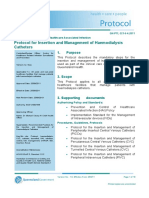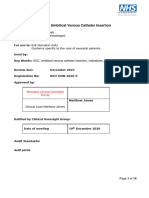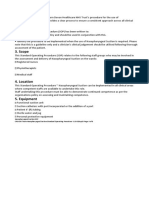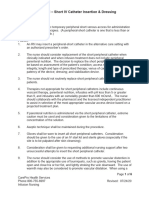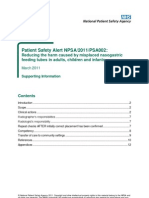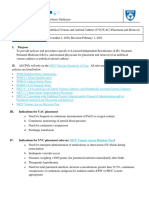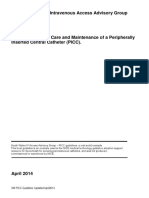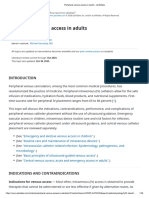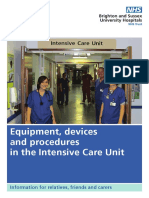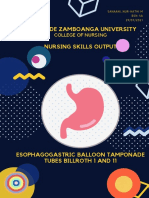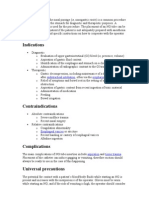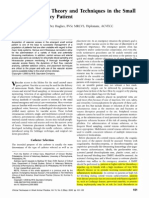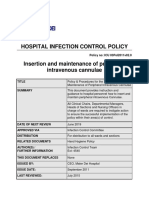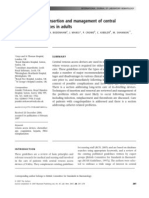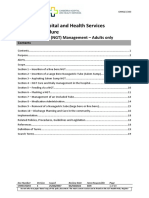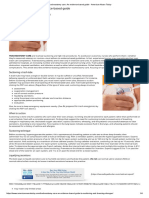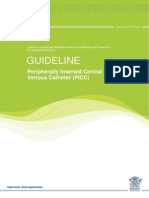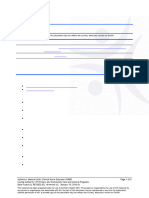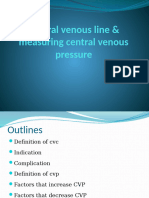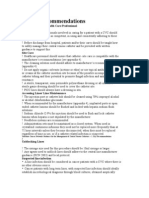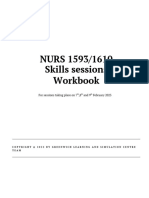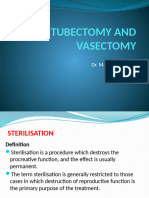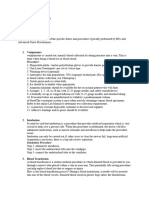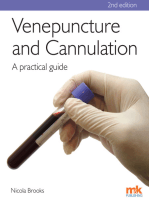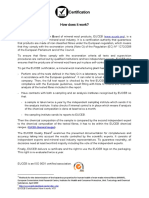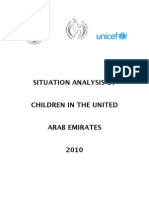Central Venous Surgical Catheter or Long Line, Management of A Baby With
Central Venous Surgical Catheter or Long Line, Management of A Baby With
Uploaded by
ChiduCopyright:
Available Formats
Central Venous Surgical Catheter or Long Line, Management of A Baby With
Central Venous Surgical Catheter or Long Line, Management of A Baby With
Uploaded by
ChiduOriginal Description:
Original Title
Copyright
Available Formats
Share this document
Did you find this document useful?
Is this content inappropriate?
Copyright:
Available Formats
Central Venous Surgical Catheter or Long Line, Management of A Baby With
Central Venous Surgical Catheter or Long Line, Management of A Baby With
Uploaded by
ChiduCopyright:
Available Formats
Nottingham Neonatal Service Clinical Guidelines
Guideline G3
Title:
Guideline for the management of a baby with a central venous
surgical catheter or long line
Version:
Ratification
Date:
Review Date:
Approval:
Author:
Job Title:
Consultation:
Guideline
Contact
Distribution:
Target
audience:
Patients to
whom this
applies:
Key Words:
Risk
Managed:
Evidence
used:
(Vers1 July 2000)
January 2013
November 2015
Nottingham Neonatal Service Clinical Guideline Meeting
Dr Colin Gilhooley, Dr Don Sharkey, (v1 Pru Fox)
Speciality Trainee (ST4) & Consultant Neonatologist (v1 Neonatal
Nurse)
Nottingham Neonatal Service Staff and Clinical Guideline Meeting.
Dr Stephen Wardle, Guideline Coordinator and Consultant
Neonatologist co/ Stephanie Tyrrell, Nottingham Neonatal Service
stephanie.tyrrell@nuh.nhs.uk
Nottingham Neonatal Service, Neonatal Intensive Care Units.
Staff of the Nottingham Neonatal Service.
Patients of the Nottingham Neonatal Service who fit the inclusion
criteria of the guideline below
Central line, catheter, long line, broviac.
Minimise infection risk, misplacement of line, reduce
risk of cardiac tamponade
The contemporary evidence base has been used to develop this
guideline. References to studies utilised in the preparation of this
guideline are given at its end.
Clinical guidelines are guidelines only. The interpretation and application of clinical
guidelines remain the responsibility of the individual clinician. If in doubt, contact a
senior colleague. Caution is advised when using guidelines after the review date.
This guideline has been registered with the Nottingham University Hospitals NHS
Trust.
This guideline does not include umbilical lines, for these please
refer to guidelines G1 and G5.
Key recommendations for central venous catheter insertion
Aseptic technique is essential to reduce the risk of catheter
associated infection.
Remember the tip of the line must lie outside of the cardiac
silhouette to reduce the risk of cardiac tamponade.
Daily documentation of line dressing and insertion site (if
visible) must occur and action taken to remedy any concerns.
Page 1 of 16
Nottingham Neonatal Service Clinical Guidelines
Guideline G3
Introduction/background
The two main types of central venous catheters discussed in this policy are:
Central line (Broviac - most frequently used line in neonates) made of radio-opaque silicone, it is
inserted as a surgical procedure through an incision in the upper chest or groin region, tunnelled
subcutaneously and positioned into the superior/inferior vena cava via a large vein. There is a cuff
attached to the catheter, which is positioned under the incision and helps secure the catheter
through fibrous tissue reaction, which occurs 1-2 weeks after insertion.
Silastic long line made of silastic, this fine bore catheter is aseptically inserted percutaneously into
a peripheral vein. It is advanced until the tip ideally lies in the superior or inferior vena cava.
However, insertion difficulties may result in the line tip being sited more peripherally. Nevertheless,
the line tip must be positioned in a large vein.
The term central venous catheters will be used in this guideline to describe both types of line
collectively. When the catheters are discussed separately, the name will be underlined to indicate
the difference.
1. Patient group/Indications
Central venous catheters are used for the administration of intravenous fluids, drugs and should
ideally always be used for parenteral nutrition administration.
Indications for use include:
major gastrointestinal problems and prolonged intolerance to enteral feeds
parenteral nutrition administration
where peripheral venous access is unsuccessful
requirement for drugs/infusions to be given centrally e.g. inotropes
occasionally for long term drug administration e.g. antifungal treatment
Central venous catheters are for long term use: the central line may be left in place indefinitely1, the
silastic long line should be considered for removal (and replacement if indicated) between 14 and
21 days after insertion. This guidance on the length of time a silastic long line may remain in situ
has been agreed by experienced-based consensus within the Nottingham Neonatal Service. It may
be necessary to leave the silastic long line in until the end of this time period, depending on the
babys clinical condition, especially in those babies with difficult intravenous (i.v.) access.
If possible, bolus and intermittent drug administration via both types of catheters should be avoided
as repeated manipulation of the lines are the main source by which bacteria are introduced.3 Bolus
administration also increases the risk of line rupture1,2,5,6. Peripheral venous access via standard
intravenous cannula should be the first choice in these situations. The exception to this rule is the
early care pathway for preterm infants <28 weeks gestation who have a UVC in when a double
lumen can be used to give drugs in order to preserve other veins (see Guidelines A8 and G5).
Central venous catheters ideally should only be used for bolus/intermittent drug
administration when peripheral vascular access is difficult. This should be discussed with
the NICU Consultant within 24 hours of commencing this strategy.
Blood products should not be administered via a silastic long line, as the fine bore catheter
will occlude.
Page 2 of 16
Nottingham Neonatal Service Clinical Guidelines
2.
Guideline G3
Placement of central venous lines
Following 4 neonatal deaths, in Manchester, thought to be directly related to central venous
catheters, the Department of Health recommended that:
Central venous catheters should be inserted by or under direct supervision of an individual
competent in the use of such devices.
and
..the ideal positioning of the catheter tipinserted specifically for parenteral nutrition in this age
group should be sited outwith the cardiac chambers7,8.
2.1
Consent for central venous access
Informed written consent in the medical notes is required for surgically placed central lines. The
information giving process should include a discussion of the problems of infection, thrombus
formation, line breakage and migration, pleural effusion and cardiac tamponade.
2.2
Confirming the tip position
Guidance issued nationally recommended Assessment of catheter position should routinely be by
plain X-ray. If this is inadequate to identify the tip of the line, then the use of contrast dye should be
explored or advice sought from an experienced radiologist with regard to other imaging techniques
(e.g. contrast and ultrasound). If there is suspicion that the line is in the atrium it should be
repositioned.7,8.
In Nottingham, we undertake an appropriate X-ray to check the line tip position ideally which should
ensure the line tip is outside of the cardiac silhouette. The baby should be positioned with
consideration of the shortest route to the heart. For the arm, this is with the upper arm abducted at
90 degrees. For the leg, this is with the hip and knee extended. Contrast is not usually required
to visualise the line and should only be used after discussion with the NICU Consultant and
Radiologist. It is essential that the line tip is visualised and documented to be in a satisfactory
position prior to use, this is especially true for the smaller diameter silastic lines (e.g. Premicath).
3.
Insertion of central venous catheters
3.1 Personnel, Equipment and Insertion Procedures (silastic long line insertion only)
3.1.1 Personnel
Central line insertion
This is a sterile surgical procedure, undertaken within operating theatre conditions by those trained
to do so.
Silastic long line insertion
Silastic long line insertion is performed by a member of the medical team or an advanced neonatal
nurse practitioner who has had training and is competent to do so. A nurse or member of the
medical team who has knowledge of the infection control procedures followed for this procedure
should assist during the preparation for, and during the insertion of, the silastic long line. The
assistant should complete the Neonatal CVC Insertion Checklist (Appendix 5) with the
Page 3 of 16
Nottingham Neonatal Service Clinical Guidelines
Guideline G3
operator (person inserting the line) and file the completed form in the babys notes (see
Appendices 110 and 2).
3.1.2 Equipment (long line insertion only)
Dressing trolley (cleaned with disinfectant wipe)
Additional gauze pack
Sterile gown and towel pack
0.5% chlorhexidine
Sterile gloves (non-powdered) 2 pairs
Opaque semipermeable sterile dressing
Face mask and hat
Steristrips
Central venous line pack
Syringe 10 ml and 21G needle
Long line (a Premicath can be used if baby is very Butterfly (24G line) or Breakaway needle (28G
small <1kg or venous access difficult).
premicath) both in the line packs
Tape measure (in line pack)
24G cannula for Premicath insertion
Anglepoise lamp or cold light if preferred (in sterile 0.9% saline vials (20mls)
glove)
Syringe pump with a pressure monitoring facility
Syringe extension set with a pressure monitoring
facility and appropriate filter
Analgesia may also be required, for the non-ventilated baby this can be in the form of oral sucrose
unless contraindicated (see Guideline G6 Oral Sucrose on the NNU). In some cases it when
inserting difficult silastic long lines the use of short term muscle relaxation can help and if successful
avoid the need for a surgical line. This can only be considered in babies who are ventilated and
with no contraindications to the use of muscle relaxants. Care is needed to avoid changes with
ventilation when doing this especially for babies on minimal ventilation. If in doubt, discuss with a
senior colleague before using muscle relaxation.
3.1.3 Procedure
1. The baby must have respiratory (pulse oximetry) and cardiovascular monitoring (ECG) on when
inserting central venous catheters. This is essential as the baby will be covered in a sterile
dressing and if the line inadvertently enters the heart it could result in disturbances of heart
rate/rhythm.
2. The attending clinical and nursing team will discuss on the length of time the procedure will
normally take to avoid any excess stress for the baby. This will guide the number of attempts,
and by whom, based on how difficult/critical the line is.
3. An aseptic technique should be used2 and is undertaken by a member of the medical team or an
advanced neonatal nurse practitioner trained to do this (see self directed learning package on
aseptic non-touch technique for long line insertion). In particular, double gloving when preparing
the sterile field should occur in all instances. All equipment should be prepared using this
technique and the Neonatal CVC Insertion Checklist (Appendix 5) followed, completed and filed
in the patients notes (Appendix 1). Isolation screens should be placed around the patients
space to minimise the risk of interruptions, inadvertent desterilisation of equipment and privacy.
4. Identify the site of insertion. Suitable veins include:
-
medial antecubital fossa
long saphenous anterior to medial malleolus
temporal and posterior auricular
5. Lines in the leg are associated with fewer complications, in particular infection11. Care must be
Page 4 of 16
Nottingham Neonatal Service Clinical Guidelines
Guideline G3
taken to ensure a vein is identified and not an artery.
6. Determine the length of the line by measuring from the selected vein insertion site to the right
atrium along the path of the vein. Keep a record of this length in the patients notes2.
7. Tighten the compression hub of the line (note there isnt a hub with the premicath as it is all in
one piece) and check the line patency and remove all air by priming with 0.9% saline. Ensure
the line is clamped to prevent the entry of air into the system.
8. Clean the skin with 0.5% chlorhexidine solution and allow to dry for a minimum of 30 seconds. If
the baby is <28 weeks gestation and <1 week old further clean the skin with sterile water or
0.9% saline to avoid skin damage/burns caused by the chlorhexidine and avoid excess
chlorhexidine pooling around the baby12. It is essential that the whole area of the insertion site is
sterile, this usually involves cleaning the whole arm/leg for example.
9. For the Vygon 24G long line use the 19g winged needle supplied in the pack. For the 28G
Premicath use the 24G breakaway needle or a 24G cannula (yellow).
Under no
circumstances should equipment be modified in the insertion of percutaneous long lines
in particular cannulas MUST NOT be cut in order to site these lines. If the first insertion
fails for a 24G line, the butterfly needle can be flushed with saline to eliminate clots and a further
attempt made if still the needle has remained sterile.
10. If using the 24G cannula for Premicath insertion, remove the cannula from the vein once the line
is in place. This cannula is then taken back to the hub of the Premicath and secured in place
under the sterile dressing so reducing the risk of infection. If using a Premicath with a guidewire
the guidewire should be removed once the line is inserted and prior to fixing in position.
11. Thread the silicone line through the needle/cannula using non-toothed forceps to the final
position. Do not withdraw the catheter back through it as this may cause puncture or
embolisation of a portion of the line2.
12. Withdraw the needle/cannula, applying pressure over the vein to achieve homeostasis. Be
careful not to pull out the line. If using the Vygon 24G long line you will need to remove the blue
hub and slide the needle out over the line, then replace the hub.
13. Insert the proximal end of the silicone line into the blue portion of the compression hub until a
definite stop is experienced. Tighten the blue portion. The thick black ring on the line should
not be visible at the distal end of the blue compression hub2.
14. Flush the line slowly to check patency, using a 10ml syringe. Do not attempt to aspirate blood to
determine location2. Do not use syringes less than 10mls as the pressure applied can rupture
the line.
15. Secure the line in a loop without causing any strain on the tubing or coiling too tight creating
increased resistance. A small piece of gauze should be placed under the hub and, if using a
cannula to aid insertion, under the cannula to prevent skin irritation/damage from the line over
the prolonged period it is in.
16. Secure the blue/white hub and extension line to the patient to prevent any strain on the silastic
line. Ensure the site is as clean as possible removing any blood from the procedure to reduce
the risk of infection.
17. Apply a transparent semipermeable dressing once homeostasis is achieved.
18. Attach a maintenance infusion of 0.9% saline at the rate of 1 ml/hour until the position of the line
Page 5 of 16
Nottingham Neonatal Service Clinical Guidelines
Guideline G3
has been checked following an X-Ray. Order X-Ray immediately.
19. Clear all equipment away and dispose of all sharps appropriately.
20. Complete the central venous catheter proforma (Appendix 2) and stick this in the babys notes.
This includes inserting the line sticker (on the pack giving the batch number) and the sterile pack
barcode for tracking at a later date if necessary. Document the length of line inserted and
how far in the line was advanced. Ensure this is complete.
21. Check the line tip is in a satisfactory position in a large vein and outside the cardiac silhouette.
Inform the relevant staff that the line may now be used. Ensure that the line tip position is
documented before use.
Remember the tip of the line must lie outside of the cardiac silhouette to
reduce the risk of cardiac tamponade.
22. It is essential that an appropriate pressure is set on the infusion pump to prevent blockage of the
line (especially if the alarm pressures are too low resulting in frequent flow interruptions to the
line) but also reduce the risk of line damage. The pressure in the line will be dependent on two
factors 1) the rate of infusion (i.e. flow rate), the greater this is the greater the pressure; 2) the
diameter of the line (i.e. the smaller Premicath will have more resistance and hence greater
pressure will be required). Typically, pressures alarms rarely exceed 100mmHg for a 24G
Vygon line or 300mmHg for a 28G Premicath. Maximum pressures should not exceed those
given by the manufacturer (refer to current manufacturers instructions in pack) and the charts in
Appendix 3 used as a guide. Any central line with recurrent interruptions/alarms should be
reviewed to exclude any complications and reduce the risk of line blockage.
4.
Changing Intravenous Fluids
An aseptic technique with gloves, gown and an adequately sized sterile field for preparation
should be used. The principles that are detailed in the Guideline D12 should be followed
(Administration of intravenous drugs and fluids to neonates4). Specific care should be taken
with the following areas:
Clamping of both lines should be done using the products clamp only. The central line has
an area with a protective clamping sleeve with clear instructions on where to clamp the line.
The silastic long line should be clamped with care as the tubing can be easily damaged2.
All connections should be tightened and should use a Luer lock connection.
The infusion pumps used must have a pressure monitoring facility and the limit set at 50
mmHg above the lines running pressure on insertion. The line pressure, date and site of
insertion are recorded in the patients notes.
Line changes should be kept to a minimum1,2,3. All intravenous fluids in the line should, if
possible, be changed at the same time.
All lines and connections are cleaned by the assistant first and then again by the person
carrying out the changing procedure.
The change must be quick to ensure that a running infusion is maintained to ensure patency.
Page 6 of 16
Nottingham Neonatal Service Clinical Guidelines
5.
Guideline G3
Central venous catheter removal
Central venous catheters should be removed in a timely fashion to reduce the risk of infection.
In babies with suspected central venous line associated complications please refer to section 7
of this guideline.
Central lines may remain in situ for long periods of time even when not in use. The decision to
do this is based on a number of factors but should be discussed with the duty NICU Consultant.
-
Its removal is a surgical procedure that may occur on the unit (with appropriate training,
precautions and analgesia), or in the operating theatre environment typically for lines that
have been in for >2 weeks.
The tissue around the Surecuff may need incising and steristrips used to close the
wound.
The tip should be sent to microbiology for culture and sensitivity only if there are
concerns about possible infection.
Silastic long lines can stay in for a maximum of 28 days according to the guidance issued by the
manufacturer. However, local policy is that we aim to try and replace them before 21 days to
reduce the risks of complications, most notably infection. This often requires careful planning in
the days before to ensure any difficulties siting a new one does turn this into an urgent matter. If
the line is to remain in for >21 days this needs to be discussed with the NICU Consultant and
the reasons documented. Silastic long lines should be removed by a member of the medical
team, an advanced neonatal nurse practitioner or a critical care trained nurse competent to do
so making note of the following points:
6.1
The site should be cleared to remove all sticky residues.
Make a note of the length of line inserted and ensure the whole line is removed intact,
this must be documented.
Gentle sustained traction should be applied 2-3 cm to the exit site.
The line should not be overstretched, as it may rupture and rebound into the vein. A
finger should be placed directly over the vein so that the line can be fixed immediately
should line rupture occur6.
If the silastic long line remains firmly attached then surgical removal is needed6.
Sustained gentle pressure should be applied following removal until homeostasis occurs
and a small dressing applied.
The line tip should be sent for culture and sensitivity only if there are concerns about
infection.
Specific issues
All medical and nursing staff should use an aseptic technique with gloves when undertaking any
procedure involving a central venous catheter.
If there is no alternative peripheral intravenous access, a central venous catheter may be used
Page 7 of 16
Nottingham Neonatal Service Clinical Guidelines
Guideline G3
for bolus drug administration and this strategy agreed with the duty NICU Consultant within 24
hours. This must be done aseptically and following the principles that are detailed in the policy
D12 Administration of intravenous drugs and fluids to neonates4.
All blood products may be infused through a central line but not through a silastic long line as
the lumen is too small.
If bolus drugs are to be administered the manipulation of the line should be kept to a minimum3.
The timing of drug administrations should be planned to occur simultaneously with fluid changes
when possible. A Y-connector and Luer lock should be added to the line and changed with the
line. This should be inserted as close to the patient as possible and removed if not required. All
drug containers should be used from new, handled and cleaned by the assistant and access
aseptically by the person carrying out the technique.
When using a central venous catheter, bolus injections must be slow and preferably using a 10
ml syringe1,2,5,6. Because of the necessity to give small accurate volumes of drugs, it may be
necessary to use a smaller syringe. The line should be flushed with intravenous saline 0.9%
using the larger syringe size initially to determine patency. (The central venous catheters are at
risk of rupturing if the infusion pressure exceeds 25 psi, which may happen using a 1 or 2 ml
syringe).
If the central venous catheter becomes blocked a member of the medical team, an advanced
neonatal nurse practitioner or critical care nurse can flush the line using an aseptic technique if
competent to do so. If a central line is blocked an attempt can be made to aspirate blood back
through the wider lumen before injecting 1-2 ml of 0.9% heparinised saline (1 IU/ml) using a
10ml syringe. This should be done with a gentle pressure. For a silastic long line, do not
aspirate back, as blood will occlude the narrow lumen, but flush with 1-2 ml of heparin in 0.9%
saline solution (1 IU/ml) using a 10 ml syringe. Do not flush excess heparin saline solution in,
just enough to remove the blockage.
Central venous catheters may become damaged leading to extensive haemorrhage if
undetected. Central lines do have a repair kit, with specific instructions. There must be at least
3 cm of undamaged line left. The line must be clamped with an atraumatic clamp between the
exit site and damaged area until the damage is repaired. The repair must be completed
aseptically.
Do not clean the tubing with an alcohol, acetone or spirit based cleaning solution as these can
damage the line1.
If a central line is not being used for continuous administration of fluids, it should be flushed
twice a week with a solution containing 10 units of heparin per ml. Refer to the manufacturers
instructions so that only the volume of the line is administered. Silastic long lines should always
have a minimum of 1ml/hr running through them to prevent blockage.
6.2
Observation, monitoring and line fixation
Central venous catheters should be taped to the patient to avoid any strain being placed on the
catheter and to prevent the tube becoming kinked or damaged.
During each daily review the medical notes must state:
1) The number of days the line has been in (only necessary for long lines)
2) If the dressing is clean and intact
3) There is no evidence of infection/inflammation or phlebitis at the line site.
Page 8 of 16
Nottingham Neonatal Service Clinical Guidelines
Guideline G3
The long term central line:
-
These lines are often surgically placed in babies with very difficult IV access. It is
essential that these lines are cared for to minimise the risk of dislodgement especially
during the first 2 weeks of placement when they are at greater risk of coming out or
migrating. This requires firm anchorage of the dressing and line to prevent inadvertent
tugging of the line dislodging it.
It is recommended that a gauze and tape dressing is on for the first week until the cuff is
healed in, due to exit site exudate1. It should then be covered with an opaque
semipermeable sterile dressing.
A dressing change is recommended if there are signs of localised infection, or exudate
that is causing the dressing to lose its adhesiveness1. Two staff trained in the procedure
are required to change the dressing.
Otherwise, it is left in place until the line is
removed.
The site of entry and dressing should be examined daily for signs of infection,
inflammation or haemorrhage and documented in the medical and nursing notes.
If there are concerns that a line may have migrated or become dislodged then an X-ray
to check the position should be considered.
observations should include looking for signs of systemic infection.
The silastic long line:
-
is covered with the transparent dressing from the time of insertion.
a dressing change is recommended if there is sign of localised infection, or exudate that
is causing the dressing to lose its adhesiveness1.
two staff trained in the procedure are required to change the dressing (Appendix 4).
observations should include looking for signs of systemic infection.
If the silastic long line is peripherally placed, the area along the route of the line and over
the tip site should also be observed for sign of inflammation.
General Trust guidance4 related to intravenous therapy asks for the use of anti-syphon valves for
syringe pump infusions. These are excluded in neonatal care currently, especially when pressure
monitoring is in place. From the information available, the pressure required to open the valve in
the first instance exceeds that achieved by neonates generally13,14.
7. Complications of central venous catheters
7.1
Infection
Central venous catheters are a portal of entry for infective pathogens which can cause significant
illness. In any baby with a central venous catheter in place the team should always be aware of line
associated sepsis especially if the babys condition deteriorates.
Central venous catheters are removed if septicaemia is proven and the baby has another
established route of venous access. However, in suspected sepsis the decision whether or not to
remove a central venous catheter is a clinical one and depends on many factors, including how
critical access is. In most cases, however, removal of a central venous line in suspected sepsis is
the best alternative and should be discussed with the duty NICU Consultant at the earliest
opportunity if the line is critical to the management of the baby.
For episodes of suspected line associated sepsis it is essential the attending team undertakes an
infection screen and starts appropriate antibiotics (see Guideline C1).
Page 9 of 16
Nottingham Neonatal Service Clinical Guidelines
7.2
Guideline G3
Misplacement/Malfunction
All central venous catheter lines will have radiographic confirmation of their position and placement
of the tip outside the cardiac silhouette. If after initial placement the silastic long line tip lies within
the cardiac silhouette and requires repositioning, a repeat X-ray to confirm final position (i.e. outside
cardiac silhouette) must be performed.
All central venous catheters should be observed for evidence of thrombosis, phlebitis or
extravasation. Important warning signs include swelling along the path of the catheter, erythema,
tenderness and increasing pressures on the infusion pumps. If these occur then immediate review
of the catheter is required and appropriate action taken. The attending team must decide if an X-ray
is required to confirm position, if antibiotics are required or if the catheter needs removing. If in
doubt this should be discussed with the NICU Consultant.
Occasionally the central venous catheter may split on the external portion. For central lines it may
be possible to repair this using the manufacturers repair kit. The surgical team should review the
line and decide if repair can occur and if so this should be performed by an appropriately trained
paediatric surgeon. If a silastic long line is damaged on the external limb it is advised to remove the
line and site a new one. If access is very difficult, it may be possible to replace the external arm of
the silastic long line using aseptic technique and opening a new line pack. This should be
discussed with the NICU Consultant.
7.3
The complication of cardiac tamponade
The exact mechanism of cardiac tamponade is unclear. However, it is speculated that it results from
the placement or migration of the catheter tip into the right atrium. The trabeculae of the right atrium
may trap the tip of the catheter against the wall of the right atrium. The high pressure jet of
hypertonic parenteral nutrition then causes direct damage by inflammation and local necrosis. The
wall weakens and then perforates, leading to the accumulation of parenteral nutrition fluid in the
pericardial sac7.
7.3.1 Diagnosis and management of cardiac tamponade related to a central venous catheter
Although this is a rare complication (eleven cases were reported to the manufacturers over an eightyear period7), its severity required a high index of suspicion and it should be considered when a
baby with a central venous catheter becomes unwell and remains unwell despite routine
cardiorespiratory support. Signs of cardiac tamponade include tachycardia, poor perfusion and
soft/muffled sounding heart sounds. An urgent CXR comparing mediastinal size with recent films
may be useful if time permits. However, urgent ECHO looking for the tamponade is optimal.
As the pericardial fluid must be drained urgently, this should be discussed with the duty NICU
Consultant. To drain cardiac tamponade, a cannula (22 or 24 G) is inserted through the skin below
the xiphisternum, at an elevation of 30 degrees to the skin and advancing towards the left shoulder,
a syringe should be attached to remove all the fluid which should be like the infusate. The presence
of blood is unusual and probably suggests that the cannula has been inserted too far. The fluid
should be sent for microbiological and chemical assay9.
Audit of central venous line use
Attempts at insertion, duration of use, complications, consent rates and documentation require
frequent local audit.
Page 10 of 16
Nottingham Neonatal Service Clinical Guidelines
9.1
1.
2.
3.
4.
5.
9.2
1.
2.
3.
4.
5.
6.
7.
8.
9.
10.
11.
12.
13.
14.
Guideline G3
Allied guidelines/Information Resources
Nottingham Neonatal Service guideline D12 Administration of Intravenous Drugs and Fluids to
Neonates.
Nottingham Neonatal Service Drug Information Folder
Nottingham Neonatal Service Learning Packages: Preventing neonatal infections and video
NUH Guide to Intravenous Therapy Sixth Edition 2011
Nottingham Neonatal Service guideline G6 Oral Sucrose on the NNU
References
Bard Access Systems 1994. Hickman, Leonard and Broviac Catheters Nursing Procedure
Manual.
Vygon: Epicutaneous-care-catheter product literature.
Elliot T, Fanoqui M, Annstrong R, Hanson G. Guidelines for good practice in central venous
catheterisation. J.Hosp. Infec. 1994, 28: 163-176.
Nottingham Neonatal Service Policy D12 Administration of intravenous drugs and fluids to
neonates
Watkin S, Stephenson T. 1994. Embolization of a percutaneous central venous catheter.
Clinical Paediatrics, February, p 126.
Trotter C and Carey B. Tearing and embolization of percutaneous central venous catheter.
Neonatal Network. April 1998, Vol 17, No. 3.
Review of the deaths of four babies due to cardiac tamponade associated with the presence of
a central venous catheter. Department of health, 2001.
Review of the deaths of four babies due to cardiac tamponade associated with the presence of
a central venous catheter, Recommendations and department of health response. Department
of health, 2001.
Rennie JM, Roberton NRC. Textbook of neonatology, third edition, 2000. Chapter 51,
Procedures.
http://www.patientsafetyfirst.nhs.uk/Content.aspx?path=/interventions/relatedprogrammes/matc
hingmichigan/ accessed 5th November 2012.
Hoang V et al. Percutaneously inserted central catheter for TPN in neonates: complications
rates related to upper versus lower extremity. Pediatrics 2008; 121(5):1152-1159.
Reynolds PR, Banerjee S, Meek JH. Alcohol burns in extremely low birth weight infants: still
occurring. Arch Dis Child FN ed 2005; 90:F10.
Quinn, C. Infusion devices: risks, functions and management. Nursing Standard, March 2000,
Vol. 14, No. 26.
Alaris Medical Systems, 2000. IV Therapy. Alaris, Basingstoke.
Page 11 of 16
Nottingham Neonatal Service Clinical Guidelines
Guideline G3
Appendix 1. Neonatal Central Venous Catheter (CVC) Insertion Checklist (adapted10)
When printing patient notes copy please use the separate full page checklist
(Appendix 5) at the end of this guideline.
Page 12 of 16
Nottingham Neonatal Service Clinical Guidelines
Guideline G3
Appendix 2. Silastic Long line insertion documentation
A) NUH central line sticker placed in patients notes alongside patient identifying label
B)
C)
Example of silastic long line batch details sticker (B) and sterile pack tracking sticker (C) to
be placed with the above insertion sticker
The CVC checklist (Appendix 5) should also be completed
and inserted with the above documentation.
Page 13 of 16
Nottingham Neonatal Service Clinical Guidelines
Guideline G3
Appendix 3.
Pressure/flow charts for A) the Premicath and B) Vygon long lines (adapted from Vygon
literature, August 1997)
A)
Do not exceed a maximum
operating pressure of
760mmHg
B)
Infusate = Water
Notes: Small neonatal/paediatric catheters will often require a higher back pressure or
operating pressure to enable forward flow of the infusate than larger adult catheters. Flow
rates are also affected by the catheter design and patient physiology:
Catheter design
Inner diameter of catheter
Patient related
Peripheral blood flow around catheter
Smallest inner diameter of
the complete catheter
Overall length
Catheter material
Catheter tip location
Temperature of the patient and infusate
Catheter fixation
Viscosity of infusate
In order to maximise the flow rate
Avoid insertion in areas of flexion which may
occlude catheter
Insert the smallest catheter possible into the
largest vein to maximise peripheral blood flow
Locate the catheter tip in a large vessel e.g. SVC
Match infusate and body temperature
Page 14 of 16
Nottingham Neonatal Service Clinical Guidelines
Guideline G3
Appendix 4. Fixing and redressing a silastic long line
-
Ensure that haemostasis has been attained and the site is as clean as blood under the
dressing may be a medium for the growth of skin commensals.
Secure the line in a loop without causing any strain on the tubing or coiling too tight as
these will create increased resistance or block the line using thin adhesive strips e.g.
Steristrips. The Steristrips must not fully encircle the limb
Place a small piece of gauze under the Vygon hub/ the insertion cannula for the
Premicath to prevent skin irritation/damage from the line.
Secure the blue/white hub and extension line to the patient to prevent any strain on the
silastic line.
Apply a transparent dressing once homeostasis is achieved. The steristrips, the hub
including its coloured and transparent parts and the line between the hub and insertion
site should be completely covered by the transparent dressing which must fully
adher to the limb but must not fully encircle the limb.
Page 15 of 16
Nottingham Neonatal Service Clinical Guidelines
Appendix 5
When printing patient notes copy
please use this checklist
Guideline G3
Place patient
sticker here
Neonatal Central Venous Catheter (CVC)
Insertion Checklist
This checklist should be completed by an observer/assistant. The procedure must be stopped if
any of these elements of this CVC care bundle checklist are not followed
Babys Name:
Babys Unit No:
Procedure:
Date:
Operator/s:
Observer:
Time:
Before the procedure
1
Required equipment gathered
Designated trolley cleaned
Hat & mask worn by operator (& assistant if required to be sterile)
Hands decontaminated by operator/assistant
Sterile gown and gloves worn by operator (& assistant if sterile)
Yes No
During the procedure
6
0.5% Chlorhexidine/70% isopropyl alcohol used for skin prep and
allowed to dry for 30 seconds
Use a large sterile drape to cover infant
Sterile field maintained (if applicable sterile sheath/glove used for
light source)
Sterile field covered with sterile towel while awaiting X Ray
N/A
N/A
After the procedure
10
Sterile dressing used (e.g. IV 3000 or Tegaderm)
11
Attach closed needle-free system (e.g. extension line; Luer locks)
12
Decontaminate hands after removal of gloves (Wash/Gel)
Signed: Operator. Observer/assistant...
Procedure stopped - Comments:
Completed checklist to be filed in the babys notes along with central line insertion stickers.
Page 16 of 16
You might also like
- Dialysis-Protocol For HD Catheter InsertionDocument18 pagesDialysis-Protocol For HD Catheter InsertionDewi Ratna SariNo ratings yet
- The Non Formal EducationDocument4 pagesThe Non Formal EducationPearl Joy Mijares100% (4)
- The Dermocosmetics MarketDocument16 pagesThe Dermocosmetics MarketRameez Naeem ヅNo ratings yet
- Care Bundle For Insertion and Maintenance of Central Venous Catheters Within The Renal and Transplant UnitDocument14 pagesCare Bundle For Insertion and Maintenance of Central Venous Catheters Within The Renal and Transplant Unitnavjav100% (1)
- 9, Procedure of PICCDocument9 pages9, Procedure of PICCputriseptinaNo ratings yet
- SP30 Neonatal Umbilical Vessel Catherization (Neonatal)Document13 pagesSP30 Neonatal Umbilical Vessel Catherization (Neonatal)Ritzjerald Christer Abrena PahilanNo ratings yet
- Clinical Guideline: Umbilical Venous Catheter InsertionDocument14 pagesClinical Guideline: Umbilical Venous Catheter InsertionCrisu AlexandraNo ratings yet
- Insertion Mangement Peripheral IVCannulaDocument20 pagesInsertion Mangement Peripheral IVCannulaAadil AadilNo ratings yet
- Procedure-Central Venous Access Catheter InsertionDocument18 pagesProcedure-Central Venous Access Catheter Insertionmohamad dildarNo ratings yet
- BAPM CVC Final Jan16 Addition Aug 2018Document18 pagesBAPM CVC Final Jan16 Addition Aug 2018g85kby6xy4No ratings yet
- Na So Faring EalDocument5 pagesNa So Faring EalDian Putri ListyantiNo ratings yet
- Newcastle Neonatal Service Guidelines Vascular AccessDocument5 pagesNewcastle Neonatal Service Guidelines Vascular AccessVineet KumarNo ratings yet
- Umblical CatheterizationDocument6 pagesUmblical CatheterizationdiyalintuNo ratings yet
- Central LinesDocument7 pagesCentral LineslaneeceshariNo ratings yet
- Guidelines For The Insertion and Management of Chest Drains: WWW - Dbh.nhs - UkDocument14 pagesGuidelines For The Insertion and Management of Chest Drains: WWW - Dbh.nhs - UkStevanysungNo ratings yet
- Nasogastric Tube InsertionDocument11 pagesNasogastric Tube InsertionDiane Kate Tobias Magno100% (2)
- C AnnulationDocument15 pagesC AnnulationSaffronMaeNo ratings yet
- Peripheral IV Insertion & DressingDocument6 pagesPeripheral IV Insertion & Dressingday alcoberNo ratings yet
- Nasogastric Tube Placement GuidelinesDocument17 pagesNasogastric Tube Placement Guidelinesdrsupriyagmc9507100% (1)
- I. Purpose: Clinical Practice Policy: Effective DateDocument7 pagesI. Purpose: Clinical Practice Policy: Effective DatesalamredNo ratings yet
- Guidelines For The Care and Maintenance of A Peripherally Inserted Central Catheter Velindre Cancer Centre PDF 4481503170Document32 pagesGuidelines For The Care and Maintenance of A Peripherally Inserted Central Catheter Velindre Cancer Centre PDF 4481503170doctornasirNo ratings yet
- Adult and Paediatric Oral/nasal-Pharyngeal SuctioningDocument13 pagesAdult and Paediatric Oral/nasal-Pharyngeal SuctioningRuby Dela RamaNo ratings yet
- Covid y TraqueostomíaDocument9 pagesCovid y TraqueostomíaCatalina Muñoz VelasquezNo ratings yet
- 2 150507152224 Lva1 App6892Document55 pages2 150507152224 Lva1 App6892poojaNo ratings yet
- Peripheral venous access in adults - UpToDateDocument39 pagesPeripheral venous access in adults - UpToDatethanhfmt25No ratings yet
- Equipment Devices and Procedures in The Intensive Care UnitDocument16 pagesEquipment Devices and Procedures in The Intensive Care UnitJade ParkNo ratings yet
- Equipment Devices and Procedures in The Intensive Care Unit PDFDocument16 pagesEquipment Devices and Procedures in The Intensive Care Unit PDFJena Rose ReyesNo ratings yet
- No. 10 SANAANI Topic For Esophagogastric Balloon Tamponade Tubes Billroth 1 and 11Document12 pagesNo. 10 SANAANI Topic For Esophagogastric Balloon Tamponade Tubes Billroth 1 and 11Nur SanaaniNo ratings yet
- ICU Burns GuidelineDocument24 pagesICU Burns GuidelineJonas BlaineNo ratings yet
- Percutaneous Nephrostomy: Last Updated: January 3, 2003Document5 pagesPercutaneous Nephrostomy: Last Updated: January 3, 2003Alicia EncinasNo ratings yet
- Discuss Reasons Why Patients Might Need Central Venous AccessDocument7 pagesDiscuss Reasons Why Patients Might Need Central Venous AccessKandie LoweNo ratings yet
- Port-A-Cath: Ayah Omairi Mrs. Boughdana JaberDocument13 pagesPort-A-Cath: Ayah Omairi Mrs. Boughdana Jaberayah omairi100% (1)
- Nasogastric Tubes PDFDocument8 pagesNasogastric Tubes PDFGyori ZsoltNo ratings yet
- Ccu NotesDocument76 pagesCcu NotesAr PeeNo ratings yet
- Acesso Vascular EmergenciaDocument9 pagesAcesso Vascular EmergenciaSílvia TrindadeNo ratings yet
- Peripheral Intravenous Cannulation PolicyDocument14 pagesPeripheral Intravenous Cannulation PolicyRoksana AkhterNo ratings yet
- Tracheostomy Care - An Evidence-Based Guide To Suctioning and Dressing Changes - American Nurse TodayDocument5 pagesTracheostomy Care - An Evidence-Based Guide To Suctioning and Dressing Changes - American Nurse TodaySheena CabrilesNo ratings yet
- Guidelines On The Insertion and Management of CentralDocument18 pagesGuidelines On The Insertion and Management of CentralAgustina ItinNo ratings yet
- NGT Peritoneal LavageDocument12 pagesNGT Peritoneal LavageJeffrey Dela CruzNo ratings yet
- Nasogastric Tube (NGT) Management Adults - OnlyDocument19 pagesNasogastric Tube (NGT) Management Adults - OnlyRana Zara AthayaNo ratings yet
- Tracheostomy Care - An Evidence-Based Guide - American Nurse TodayDocument4 pagesTracheostomy Care - An Evidence-Based Guide - American Nurse TodayZulaikah Nur IstiqomahNo ratings yet
- Peripherally Inserted Central Venous Catheter (PICC)Document18 pagesPeripherally Inserted Central Venous Catheter (PICC)raamki_99100% (1)
- Picc Infection PDFDocument16 pagesPicc Infection PDFMahesh ChandraNo ratings yet
- IV Catheter Insertion PDFDocument17 pagesIV Catheter Insertion PDFHannaNo ratings yet
- 1-15!1!020 Nasal BridleDocument5 pages1-15!1!020 Nasal Bridlekaylajw15No ratings yet
- Central Venous CatheterDocument5 pagesCentral Venous Catheterrajnishpathak648No ratings yet
- Central venous line.pdfDocument40 pagesCentral venous line.pdfaelnggar39No ratings yet
- Umbilical Venous CatheterDocument17 pagesUmbilical Venous CatheterdiyalintuNo ratings yet
- Paediatric TracheostomyDocument13 pagesPaediatric TracheostomyYwagar YwagarNo ratings yet
- Abdominalparacentesis 131005010712 Phpapp02Document33 pagesAbdominalparacentesis 131005010712 Phpapp02Shrish Pratap SinghNo ratings yet
- Catheterisation - Suprapubic Catheter ProcedureNewDocument12 pagesCatheterisation - Suprapubic Catheter ProcedureNewAmit KapuriaNo ratings yet
- Guidline of Management of Porta CathDocument8 pagesGuidline of Management of Porta CathroncekeyNo ratings yet
- Intravenous CannulizationDocument78 pagesIntravenous CannulizationSandhya BasnetNo ratings yet
- Peripheral Arterial Catheter Insertion and RemovalDocument6 pagesPeripheral Arterial Catheter Insertion and RemovalSayan ChattopadhyayNo ratings yet
- Skills Workbook 8thDocument10 pagesSkills Workbook 8thjhust.hannahNo ratings yet
- Central Venous Catheters: Iv Terapy &Document71 pagesCentral Venous Catheters: Iv Terapy &Florence Liem0% (1)
- Tubectomy and VasectomyDocument59 pagesTubectomy and VasectomyThippagalla Harshitha HarshithaNo ratings yet
- Tgs Chelsa Individu Mr. BingsDocument4 pagesTgs Chelsa Individu Mr. Bingsjeffriwahyudi91No ratings yet
- Intravenous Therapy Administration: a practical guideFrom EverandIntravenous Therapy Administration: a practical guideRating: 4 out of 5 stars4/5 (1)
- Englisch DasWirken 2003 ADocument55 pagesEnglisch DasWirken 2003 Abagus918No ratings yet
- Conducting A Performance Appraisal InterviewDocument18 pagesConducting A Performance Appraisal InterviewsupreetkaurNo ratings yet
- Colombia and Free Trade Agreements: Between Mobilisation and ConflictDocument9 pagesColombia and Free Trade Agreements: Between Mobilisation and ConflictLaauu KaasteellaanosNo ratings yet
- Extended Spectrum Beta Lactamase Dan Beta Lactamase Ampisilin Kelas C Yang Diproduksi Escherichia Coli Dari Hewan MakananDocument14 pagesExtended Spectrum Beta Lactamase Dan Beta Lactamase Ampisilin Kelas C Yang Diproduksi Escherichia Coli Dari Hewan MakananAnonymous Gvten4DxNo ratings yet
- HEAD TO TOE - Health Assessment in Nursing 5th Edition (Weber & Kelley)Document20 pagesHEAD TO TOE - Health Assessment in Nursing 5th Edition (Weber & Kelley)folkloriantaro100% (1)
- Unicef Indonesia: To Apply Please Click On The Job No. 525947Document2 pagesUnicef Indonesia: To Apply Please Click On The Job No. 525947sri wusonoNo ratings yet
- Personal Details: 22001448 Sonu Antony Antony Joseph Gracy Antony Indian No Male 20/aug/1994Document5 pagesPersonal Details: 22001448 Sonu Antony Antony Joseph Gracy Antony Indian No Male 20/aug/1994Sonu AntonyNo ratings yet
- 38 Euceb Certification How It Works v01Document1 page38 Euceb Certification How It Works v01Luis Barreiro LudeñaNo ratings yet
- OGL 481 Pro-Seminar I: PCA-Symbolic Frame WorksheetDocument5 pagesOGL 481 Pro-Seminar I: PCA-Symbolic Frame Worksheetcourtney schollmeyerNo ratings yet
- Must Have Notes For NBDE and Other Dentistry ExamsDocument175 pagesMust Have Notes For NBDE and Other Dentistry ExamsdivjotNo ratings yet
- LD50 - LC50 - Probit - Analysis-1Document20 pagesLD50 - LC50 - Probit - Analysis-1Ricky Nur FebianNo ratings yet
- Wika Safety STOP-Safety InductionDocument39 pagesWika Safety STOP-Safety Inductionrtyuibnm100% (1)
- Marasmus TatalaksanaDocument4 pagesMarasmus TatalaksanaAgung Wijaya SaputraNo ratings yet
- Annual Report Year 2019Document203 pagesAnnual Report Year 2019Suresh VermaNo ratings yet
- Patient Name: Lorna Dimagiba Age: 84 Years Old Gender: Female C.S: Widow BED#: 1 Date / Shift/ Time Focus Notes (Data, Action, Response)Document4 pagesPatient Name: Lorna Dimagiba Age: 84 Years Old Gender: Female C.S: Widow BED#: 1 Date / Shift/ Time Focus Notes (Data, Action, Response)Fau Fau DheoboNo ratings yet
- Cognitive BehavioralTherapyDocument12 pagesCognitive BehavioralTherapyJulian PintosNo ratings yet
- Review On Formulations of Rasakarpura (Mercurial Salt) : Ayurpharm Int J Ayur Alli Sci., Vol.2, No.3 (2013) Pages 69 - 76Document8 pagesReview On Formulations of Rasakarpura (Mercurial Salt) : Ayurpharm Int J Ayur Alli Sci., Vol.2, No.3 (2013) Pages 69 - 76Mayur MulyeNo ratings yet
- EP 101: Components of The EP Study, Part 1: For Personal Use OnlyDocument3 pagesEP 101: Components of The EP Study, Part 1: For Personal Use OnlyGesiel Angeli ContiNo ratings yet
- 5 - Aratiles-WHOLE PAPER PDFDocument22 pages5 - Aratiles-WHOLE PAPER PDFCindy MarquezNo ratings yet
- Homoeo at A Glance PDFDocument12 pagesHomoeo at A Glance PDFNarasimharao VennelakantiNo ratings yet
- Sexiest WeightDocument3 pagesSexiest Weightzkumalo_valentine0% (2)
- Piis0002937811009185 PDFDocument24 pagesPiis0002937811009185 PDFLailatuss LelaNo ratings yet
- Syncope: Submitted By, Nikketta Nunez Iv Part Ii BdsDocument45 pagesSyncope: Submitted By, Nikketta Nunez Iv Part Ii BdsAngello Nikketta NunezNo ratings yet
- Marfan SyndromeDocument4 pagesMarfan SyndromeAtheer AlenziNo ratings yet
- RXT0715 SeDocument29 pagesRXT0715 SeVVAFilipinasNo ratings yet
- Essential BLS - BCLS Training GuideDocument28 pagesEssential BLS - BCLS Training Guidefaheemsofi55No ratings yet
- Perceptions of Home Cooking'Document12 pagesPerceptions of Home Cooking'Gabriela Brito de Lima SilvaNo ratings yet
- Unicef Situation AnalysisDocument262 pagesUnicef Situation Analysisvivian_nereim100% (1)
